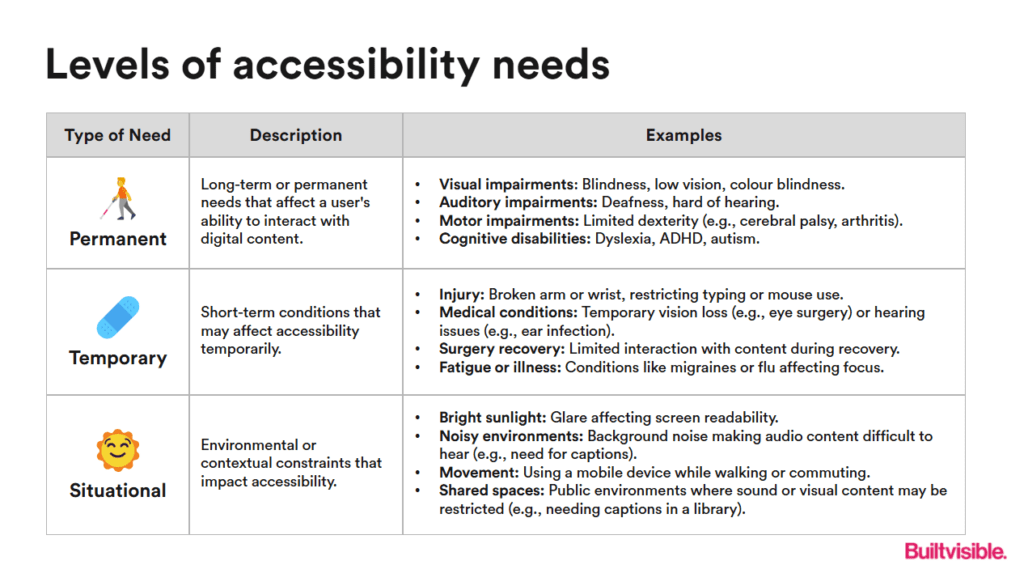The EAA and marketing
Before we dive into the business cases, here’s a quick summary of how the EAA provides a marketable opportunity.
- Enhanced SEO: Search engines prioritise user-friendly websites, and accessibility improvements go hand-in-hand with SEO best practices. By making content accessible to all users, you can improve SERP visibility, driving more traffic from organic search.
- Expanded audience reach: Inclusive websites allow you to expand your reach, engage with a larger audience, and discover new customer segments. This includes one essential but often overlooked demographic: the growing number of older adults who are frequent internet users.
- Increased retention and loyalty: Today’s consumers are value-driven, with loyalty often rooted in how brands support inclusivity. Accessibility compliance signals your commitment to all users, deepening loyalty and reducing churn.
- Improved UX across devices: Making websites easier to navigate for all users leads to more satisfying online experiences, which can significantly impact user satisfaction, brand perception, and conversion rates.
- Lower CPA: Accessibility upgrades lower your cost per acquisition by streamlining user journeys and reducing friction points, making it easier for potential customers to find you, engage with your content, and make purchases.
To learn more about the above, join our upcoming webinar on the 19th of November, “Accessibility for Competitive Advantage: What Every Marketer Needs to Know”. Now let’s look at some of the above in more detail.
Case 1: You’re leaving money on the table
An underserved audience
According to the World Health Organisation, 1 in 6 people are disabled worldwide – that’s about 1.3 billion people. In the UK, 16.1 million people – just over 1 in 5 – are living with a disability. And, the global disposable income of those with disabilities (and their close family) is estimated to be $8 trillion+.
With this in mind, if your content isn’t accessible, you’re excluding millions of potential customers with money to spend.
Yes, not all of those people will be your target demographic, but any of them could be. Even if they don’t have stereotypical digital access needs, anyone with a disability can have an access need that affects how they interact with online content. For example, a wheelchair user might need to navigate a website on their phone with one hand while controlling their chair with the other.
And if you’re operating in an oversaturated market, like the travel industry, why would you put yourself at an immediate disadvantage? Surely you’d want to reach as many people as possible with your content?
The commercial opportunity
If your products or services aren’t directly tailored for people with disabilities, it can be easy to forget this often underserved audience group. However, people with disabilities still engage with online content. Tools such as screen readers and speech recognition software enable them to do so. By ensuring your digital platforms are fit for these tools (read: accessible), you’ll provide these audiences with a better user experience and an easier path to transact.
But that’s not all. Making your website accessible isn’t just about making it usable for people who need screen readers.
When we talk about accessibility, most of us think of people with physical disabilities – such as people who are blind or deaf (those that make up the stats above) But this also disregards whole groups of people with access needs.
In the world of web accessibility, access needs can be broken down into three groups:
- Permanent – long-term needs that impact someone’s ability to engage with digital content. People who are partially sighted, people with physical disabilities (like cerebral palsy) or people with cognitive disabilities (like ADHD) fit into this group.
- Temporary – short-term circumstances which can affect someone’s access needs. This group mostly includes those with injuries or those recovering from surgery.
- Situational – environmental factors which impact accessibility. This last category can range from forgetting to wear your glasses to having a poor Wi-Fi connection.

A chart showcasing the spectrum of accessibility needs, aimed at promoting understanding and support for diverse populations.
These last two categories can affect anyone, at any time. For your website to be truly accessible, you need to take these into account as well. I’m not saying you need to design your website for customers who have broken their arms, but having a page that someone could navigate with only their keyboard or having clear alt text that describes an image that’s slow to load is a good start.
If you act now, you’ll have the edge over your competitors. As of 2023, 96.3% of websites didn’t meet WARC. If your channels do meet guidelines, not only are you tapping into a new market by being accessible, but you’re also likely to have it to yourself for the foreseeable. The bonus? By considering situational access needs, you can also reduce drop-off as users are less likely to get frustrated and exit your site.
Case 2: Accessible websites benefit from greater visibility
Brands that have committed to SEO improvements will know already that better SEO translates to increased brand visibility. But what might be less well known is that good SEO practice is very closely linked to good accessibility practice.
You’ve probably heard already of the Web Content Accessibility Guidelines mentioned above, but did you know how similar they are to SEO guidelines?
According to WCAG, to achieve AAA standard – the highest score – your web page should ‘have clear titles’ and ‘descriptive section headings’. This isn’t just great for accessibility, but is also general on-page and SEO best practice, lining up with Google’s own recommendations.
These kinds of overlaps happen time and time again, meaning that by making your website more accessible, you’re giving it an SEO boost too. So, by implementing accessibility best practices, not only are you creating content that serves an often overlooked audience group, you’re taking steps to get that content in front of those people (and the rest of your audience base) in the first place.
Conversely, where your competitors are only focusing on SEO and boosting their brand visibility, there’s no guarantee that their content will line up with accessibility user needs once they actually reach the page.
While focusing on accessibility will contribute to your organic performance, you also need SEO to push your visibility and make sure Google and humans can access your content. Therefore, a combined approach means you can really reap the rewards, as you’re more likely to draw people to your site and keep them there.
Still not convinced?
Register now for our webinar on the 19th of November. We’ve partnered with Recite Me, an industry leader in accessibility to discuss the upcoming legislation, the relationship between SEO and accessibility best practices, what you can do to ensure your brand stays ahead and the business case for doing so.
Register now – Accessibility for Competitive Advantage: What Every Marketer Needs to Know.
Conclusion
Web accessibility is often treated like a compliance or box-ticking exercise. And, if you’re a busy marketing manager with a million and one things on your plate, it’s easy to see how accessibility wouldn’t be top of your list.
But, focusing on accessibility can give you a real competitive edge and help augment all the other hard work that you’re doing to get your brand seen.
Making your content accessible means you can reach audiences that aren’t even on your competitor’s radars. And you don’t need to change your branding or come up with a fancy new product to tap into these groups either.
Prioritising accessibility will also make your SEO implementation work harder since there’s so much overlap between Google’s Quality Guidelines and accessibility criteria like WCAG. By having an accessibility and SEO strategy in place at the same time, you can get the full benefit of boosting your visibility and organic performance as those with access needs will actually be able to use and engage with your site, making them far more likely to convert and become part of your customer base.







